1958 Wheat Penny Coin Value: How Much Is It Worth?
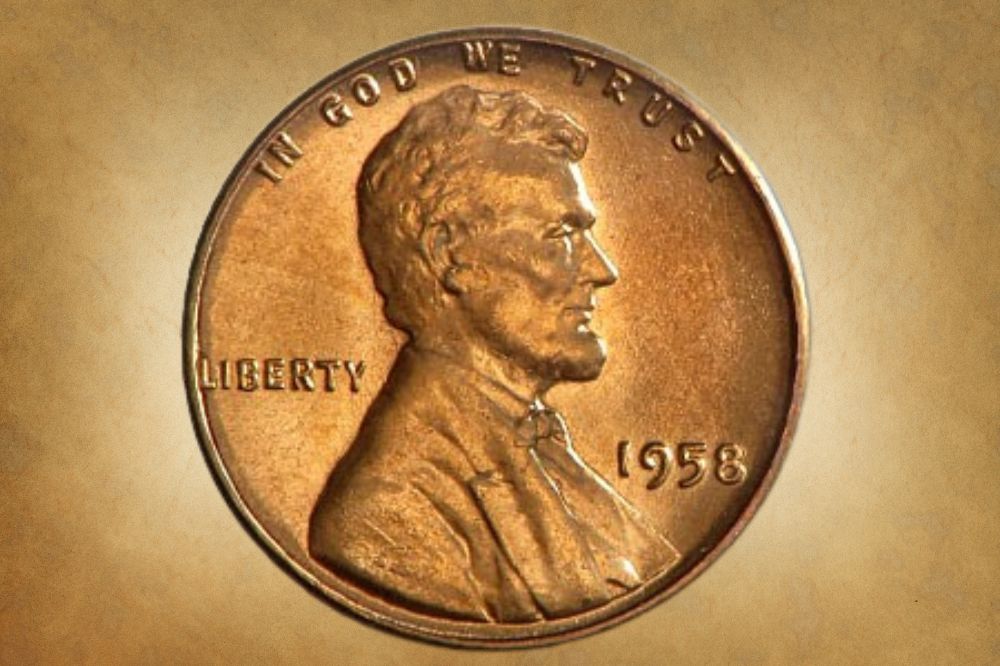
Do you have a 1958 wheat penny in your pocket? If so, what is its value? If you’re curious about the 1958 wheat penny value, you’ve come to the right place!
In this blog post, we will discuss everything you need to know about this coin. We will also take a look at the history and features of the 1958 wheat penny, as well as discuss the obverse and reverse of the coin. And don’t forget error coins!
Finally, we will give you an idea of how much your 1958 wheat penny is worth. So, if you’re thinking about collecting these pennies, make sure to keep reading. You’ll be glad you did.
1958 Wheat Penny Value Chart |
||||
| Mint Mark | Good | Fine | Extremely Fine | Uncirculated |
| 1958 “No Mint Mark” Wheat Penny | $0.01 | $0.05 | $0.13 | $0.33-$1.13 |
| 1958 “D” Wheat Penny | $0.01 | $0.05 | $0.13 | $0.33-$1.13 |
| 1958 Wheat Penny (Proof) | / | / | / | $6.65 |
1958 Wheat Penny Value guides
The 1958 wheat penny can be found in a variety of conditions, ranging from Good to Fine to Extremely Fine to Uncirculated. The condition of the coin plays a significant role in determining its value.
Generally speaking, coins that are considered Uncirculated are the most valuable and rare, followed by those coins with slight wear marks, scratches, or discoloration. For the most part, coins that show signs of wear tend to be worth less than those that are uncirculated – unless there is an error in the coin, which we will discuss later in this article.
So, you may be wondering, how much is the 1958 wheat penny actually worth? Let’s take a good look at its value below, categorized by the US Mint location.
1958 “No Mint Mark” Wheat Penny Value
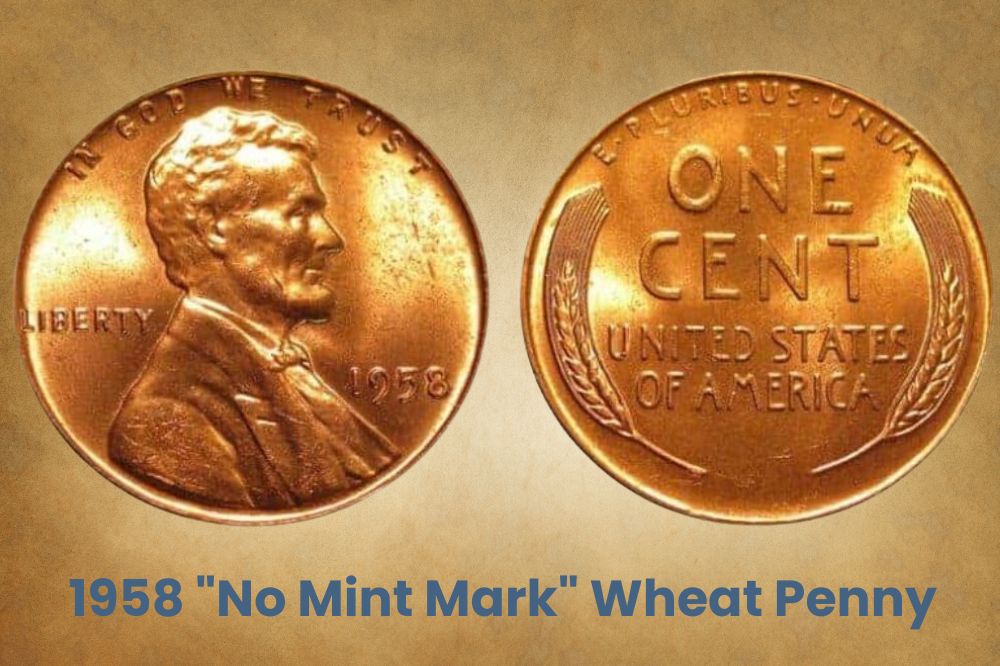
The 1958 wheat penny with no mint mark was made at the US Mint location of Philadelphia, Pennsylvania. There were 252,525,000 of these wheat pennies minted in 1958 at this location.
Depending on the condition of the coin, the value can be a whole range of prices.
For example, if you have a 1958 wheat penny that is in Good condition, it will probably be worth only face value, which is one cent. However, if you have a wheat penny from 1958 that is in Fine condition, that value jumps to five cents. If your 1958 wheat penny is in Extremely Fine condition, it is worth about thirteen cents, and Uncirculated wheat pennies from this year are worth from about 33 cents to $1.13, depending on how pristine it is.
However, one that was in near-perfect condition sold at auction recently for $150, so you just never know! The condition really makes all the difference.
1958 “D” Wheat Penny value
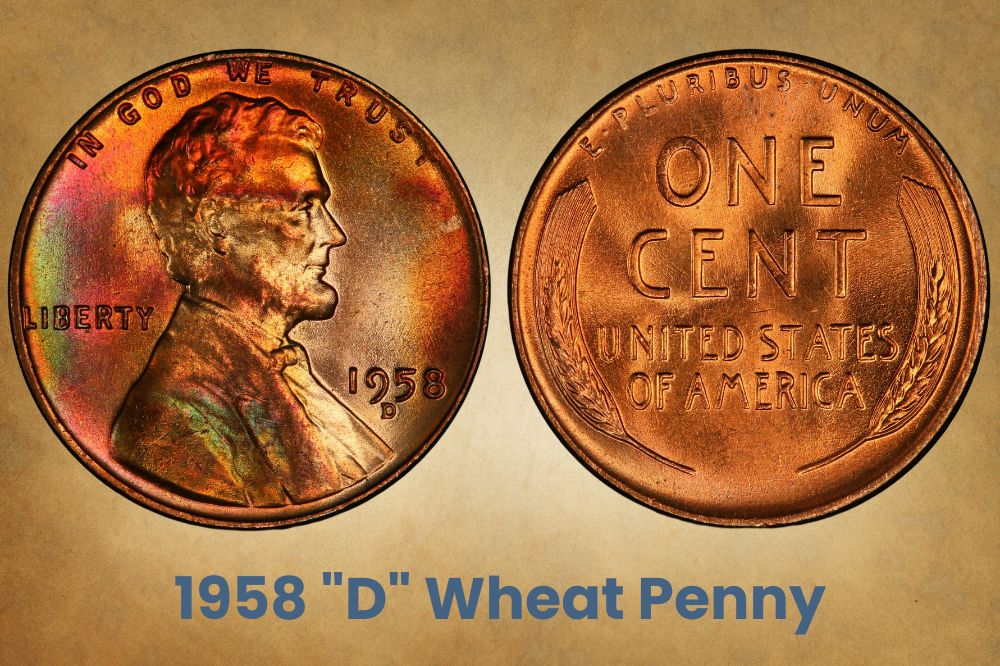
The 1958 wheat penny with the mint mark “D” was made in Denver, Colorado, at that US Mint location. There were 800,953,300 of these coins minted this year, which brings the total of pennies produced this year over one billion.
Similar to the “no mint mark” ones, its value depends on the condition it is in. Wheat pennies from 1958 with a “D” that are in good condition are worth only face value, which is one cent. Those Denver minted wheat pennies from 1958 that are in Fine condition will be worth five cents each.
If you have an Extremely Fine coin, its value increases to thirteen cents, and Uncirculated coins can be worth anywhere between 33 cents to $1.13, depending on how close to perfect they are.
1958 “Proof” Wheat Penny value
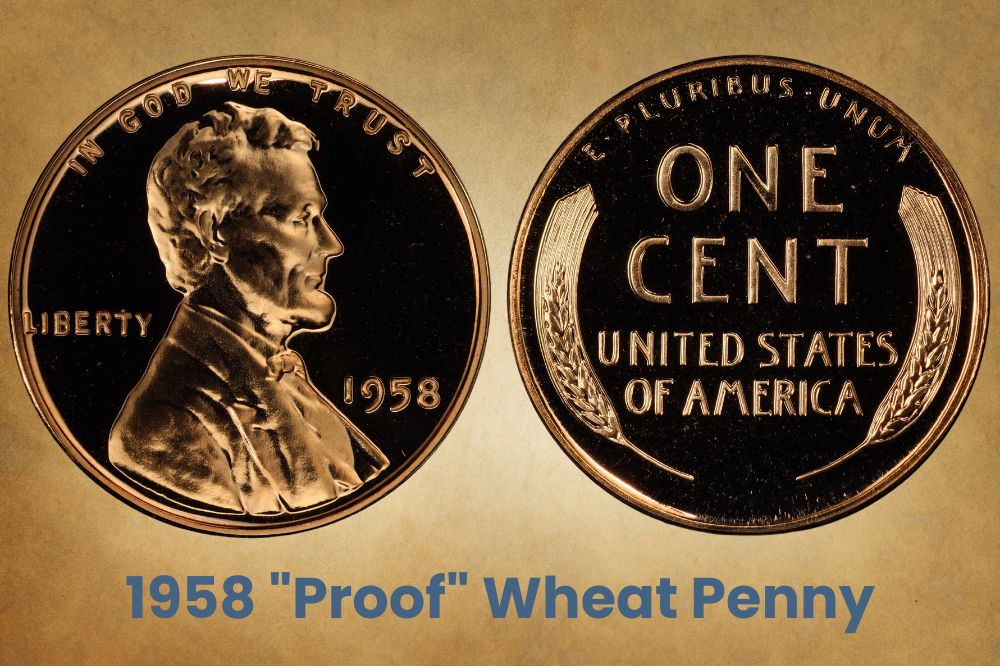
Lastly, there were Proof wheat pennies were produced at the Philadelphia US Mint location. Proof coins are coins that have been specially made for collectors with a much higher degree of quality and detail. You can recognize them by their mirror-like surface.
Usually, there are around 500 to 1000 Proof coins made each year, and they are kept back from business circulation in order to preserve their quality. This year, there were 875,652 1958 wheat pennies minted. They can be worth around $6.65 for an Uncirculated grade.
Related Posts: 16 Most Valuable Wheat Penny Errors
1958 Wheat Penny Error Coins
Now that we’ve looked at the value of the average 1958 wheat penny you will find in people’s pockets, we will move on to error coins from this year. There are a few errors in wheat pennies that you may encounter when looking for that perfect coin for your collection. One in particular is exceedingly rare and valuable.
Let’s check them out below!
1958 Wheat Penny with Improperly Annealed Error
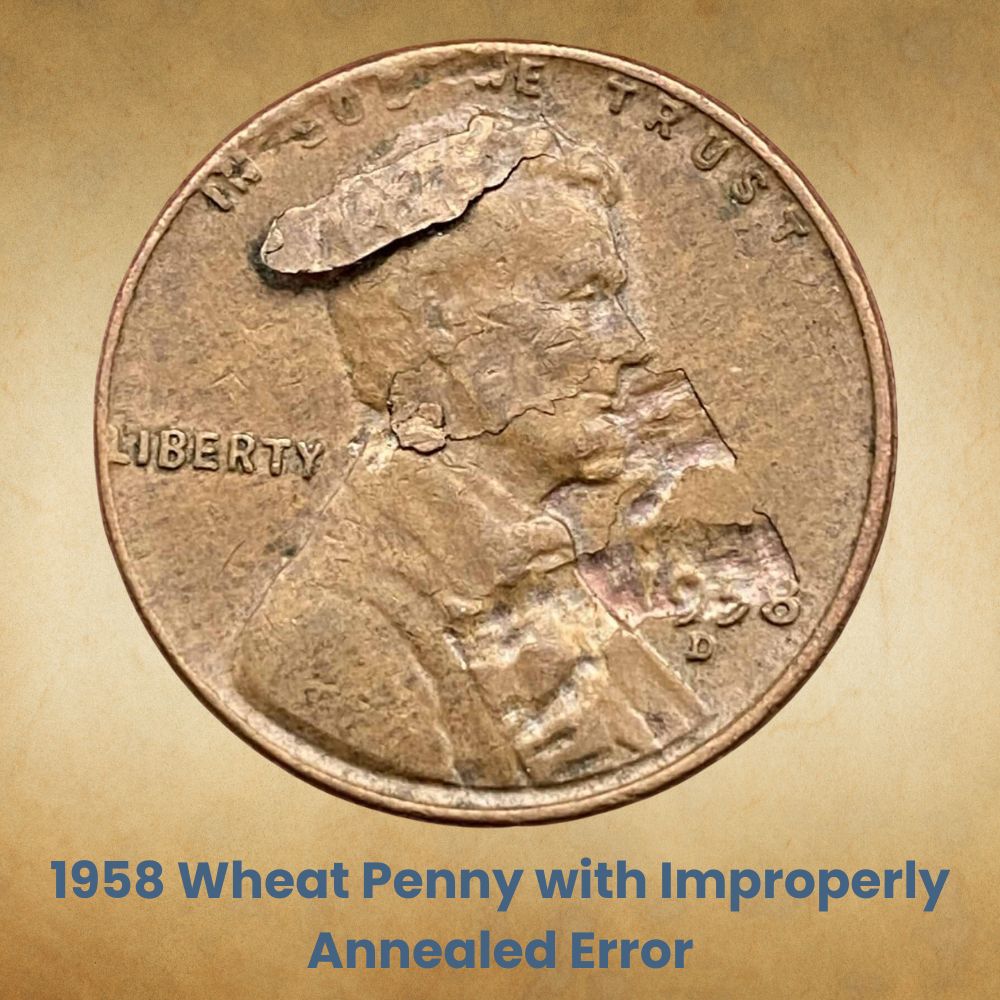
Out of the one billion wheat pennies made this year, a small number of them had improper annealing. This means that during the minting process, the metal was incorrectly heated up or cooled down. This caused these coins to have a bubbling, discoloration, or rough patches on the coin’s surface.
Oddly enough, one such 1958 wheat penny was not only struck on an improperly annealed planchet, but also on a planchet that was from Cuba!
1958 Wheat Penny with Clipped Error
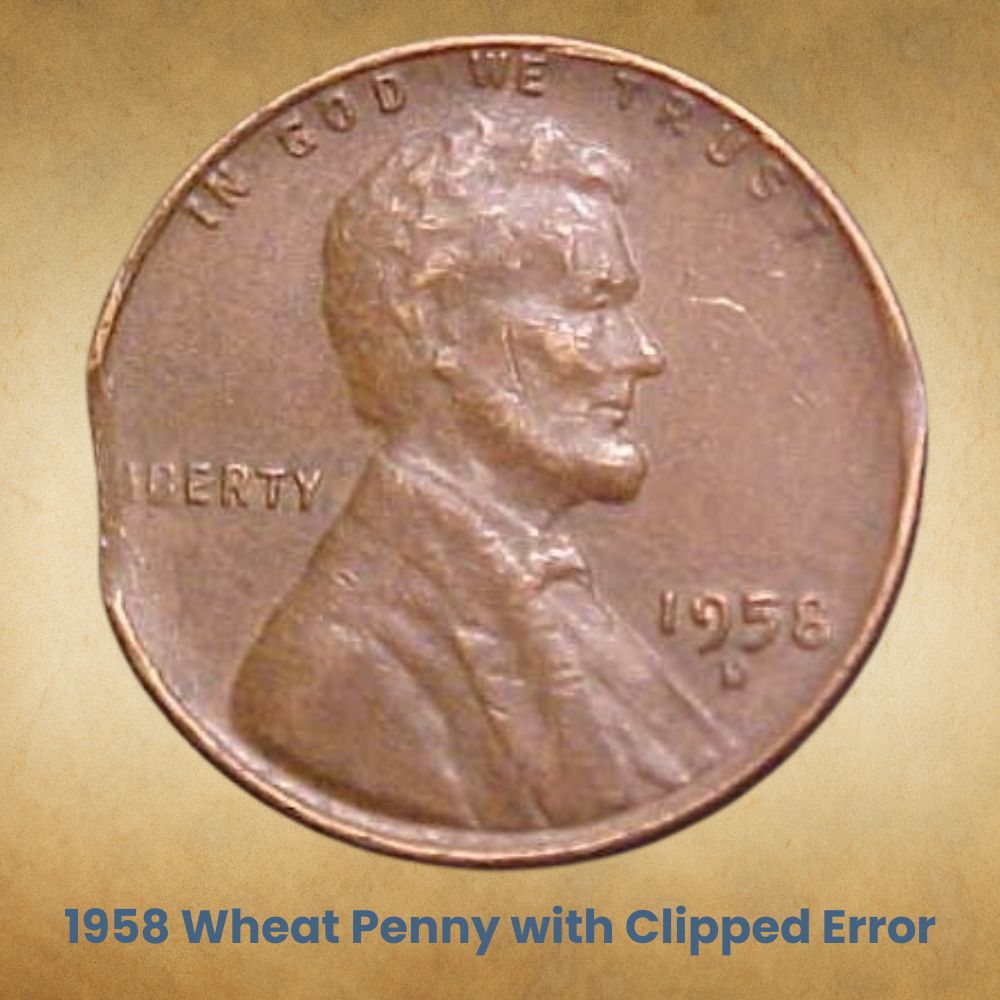
Sometimes when coins are struck, they will get a clip in them, which is like a chunk of the coin that breaks off, resulting in a crescent shaped coin. A 1958 wheat penny with this error surfaced and sold at auction recently for $400.
1958 Wheat Penny with Off Center Error
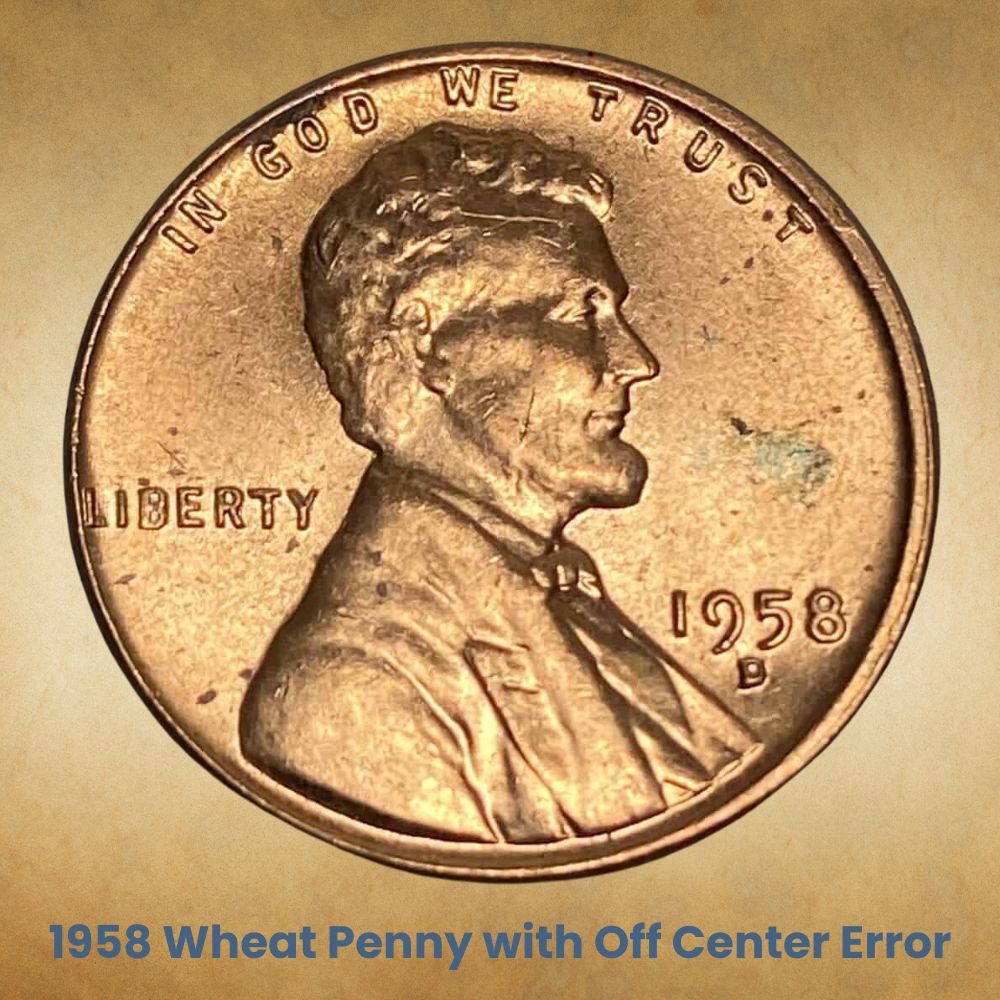
Another type of 1958 wheat penny error you may encounter is an off center strike. This happens when the die that strikes the coin is not properly aligned, thus creating a wheat penny with parts of it missing or shifted to one side. The value of these types of coins will depend on how much of the design is missing and how off centered it is.
A 1958 wheat penny with a 20% off centered strike on both sides sold at an auction recently for about $30.
1958 Wheat Penny Repunched Mint Mark Error
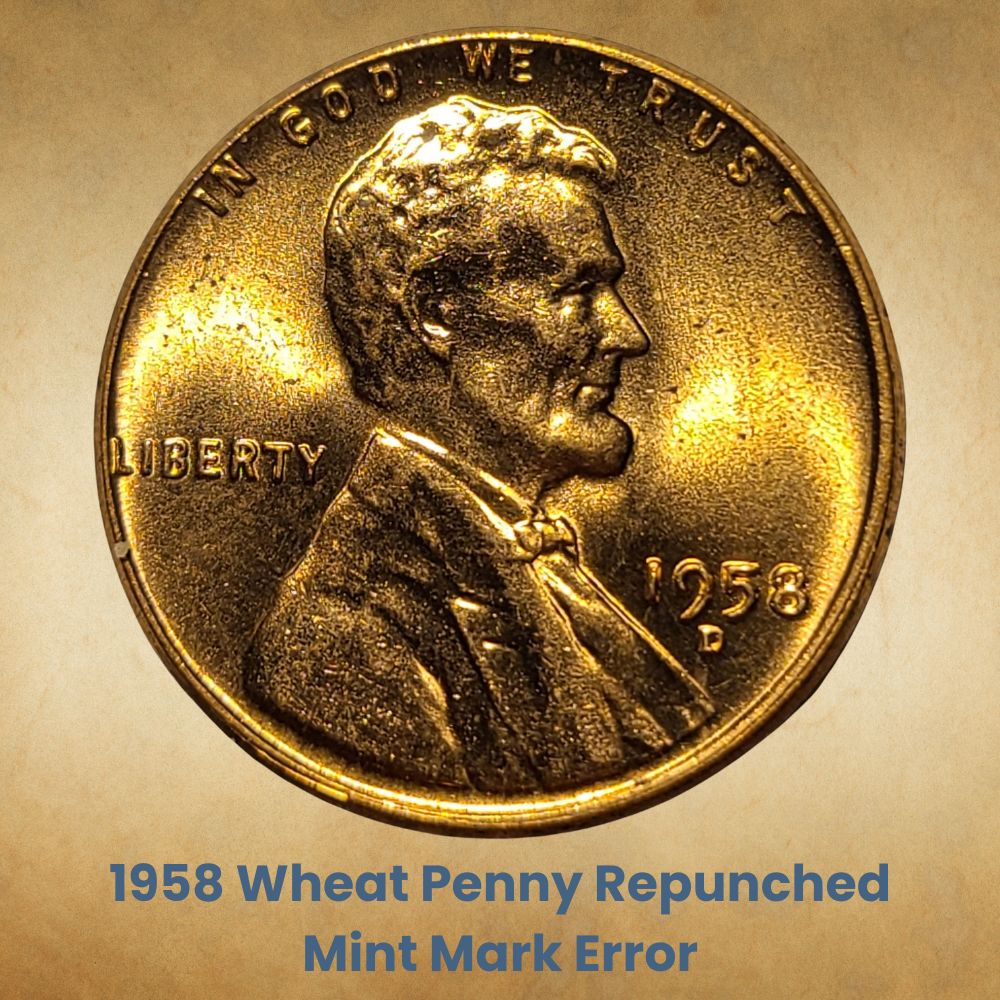
Another type of wheat penny you may come across is one that exhibits a repunched mint mark. This occurs when the mint mark is stamped twice onto the coin by mistake. You will find these from the Denver Mint, nicknamed the “D Over a D” error.
The value of these coins will depend on their condition, but usually are going for around $7 to $12 on online auction sites like eBay.
1958 Wheat Penny Struck on a Ten Cent Planchet Error
And lastly, one of the rarest 1958 wheat penny errors is one that was struck on a ten-cent planchet, meaning that it was struck on a silver Roosevelt dime. This particular error coin sold for about $900! Not too shabby for a penny!
1958 Wheat Penny with Double Die Error
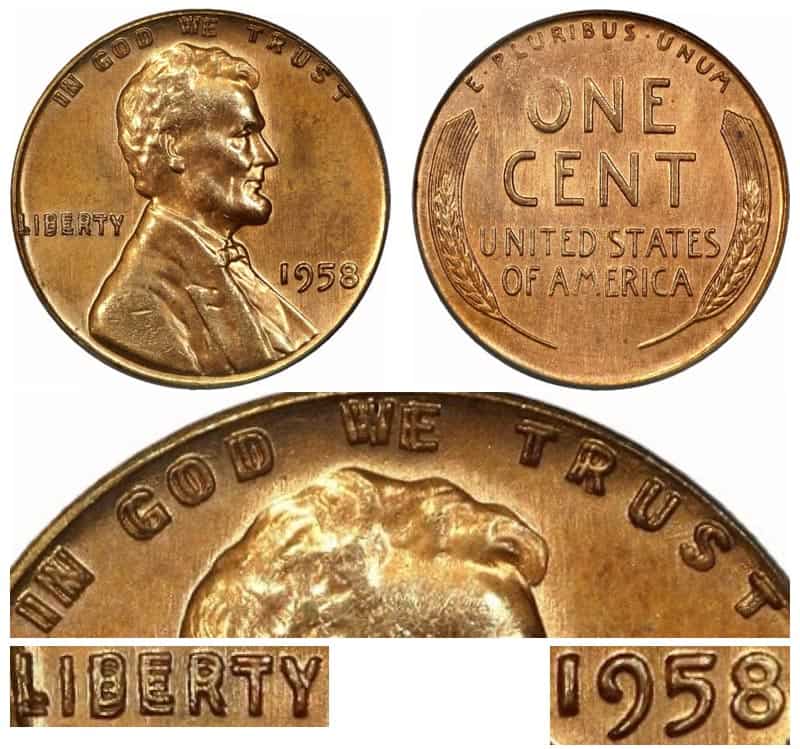
The 1958 wheat penny with a double die error is perhaps the most sought after and valuable variety from this year. It was struck twice on the obverse side, which resulted in an overlap of design elements.
According to USA Coin Book, there were only three of these coins made with this error, making it extremely rare! In Uncirculated condition, this coin is worth an amazing amount of $134,490 to $219,521!
Related Posts: 19 Most Valuable Lincoln Memorial Penny Worth Money
History of the 1958 Wheat Penny
Before we get into all the interesting features of the 1958 wheat penny, let’s learn more about its fascinating history.
The wheat penny was minted from 1909 to 1958. The artist engraver who designed the wheat penny was Victor David Brenner. He was a Lithuanian-born sculptor and engraver who made a name for himself after designing the Lincoln wheat penny.
In his earliest design of the wheat penny, his initials “V.D.B.” showed up largely at the bottom center of the reverse of the coin, between each base of the two wheat stalks. However, the U.S. Mint eventually removed the initials from the back of the penny after many complaints that it was too distracting and took away from the design of the wheat stalks.
It wasn’t long, though, before they allowed his initials to return to the coin – this time much more conspicuously, on the obverse side near Abraham Lincoln’s shoulder. Here, engraver Victor David Brenner would be remembered for all time.
As far as composition and design, the wheat penny was made mostly of copper, and it featured the image of wheat stalks on the reverse. The obverse of the coin depicted the famous profile of Abraham Lincoln, America’s beloved 16th president. In 1959, the wheat penny was replaced by the Lincoln Memorial penny, which is still in circulation today.
When the wheat penny was first minted in 1909, it was the height of America’s agricultural industry. The simple yet profound image of two wheat stalks on the reverse side of the coin was meant to represent this thriving industry. For over 50 years, the wheat penny served as a reminder of America’s agricultural roots.
However, in 1959, production of the wheat penny ceased, and as we mentioned, it was replaced on the reverse side by the Lincoln Memorial, symbolizing a new chapter in American history. Some people struggled with this transition, but overall, it was well received. The wheat penny remains one of the most iconic coins from the United States even today, over sixty years after it ceased being produced.
Today, you can still find old wheat pennies in circulation every once in a while throughout America, which is a fun find for any coin collector (also known as numismatists).
Related Posts: 19 Most Valuable Wheat Penny Worth Money
how to identify 1958 Wheat Penny
The 1958 wheat penny is widely sought after by coin collectors for its rarity and value. Now that we’ve discussed the history of the wheat penny, let’s take a look at all of its features, including the obverse side design, the reverse side design, and other features such as its metal composition, mint mark locations, and size and weight.
The Obverse of the 1958 Wheat Penny
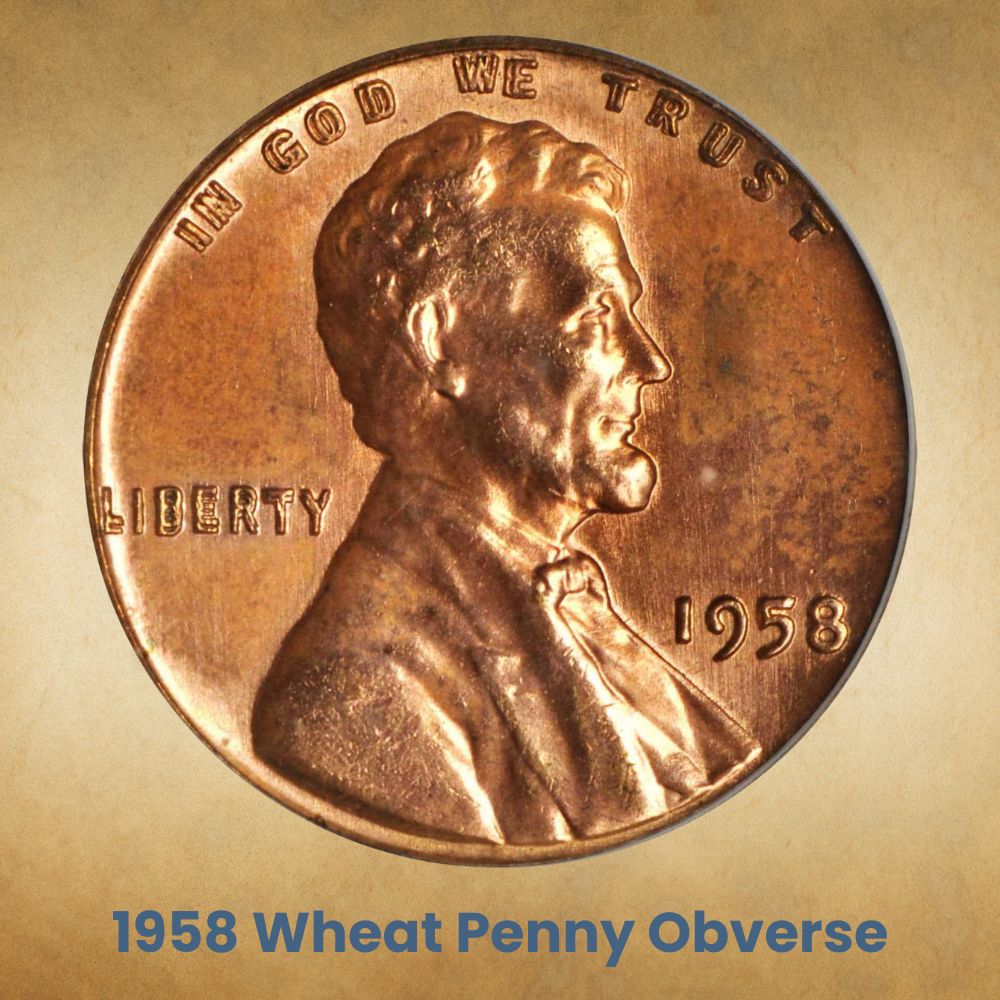
The obverse side of the 1958 wheat penny features a profile view of Abraham Lincoln, looking right, and dressed in a stately suit, as per usual. Engraved into the top of the coin is the phrase, “IN GOD WE TRUST,” as well as the year (on the lower right side) that it was issued: “1958.” You will also find the word “LIBERTY” on the left, behind Lincoln’s shoulder. Above the date, you will find a small mint mark letter, if there is one, indicating where the coin was made.
The Reverse of the 1958 Wheat Penny
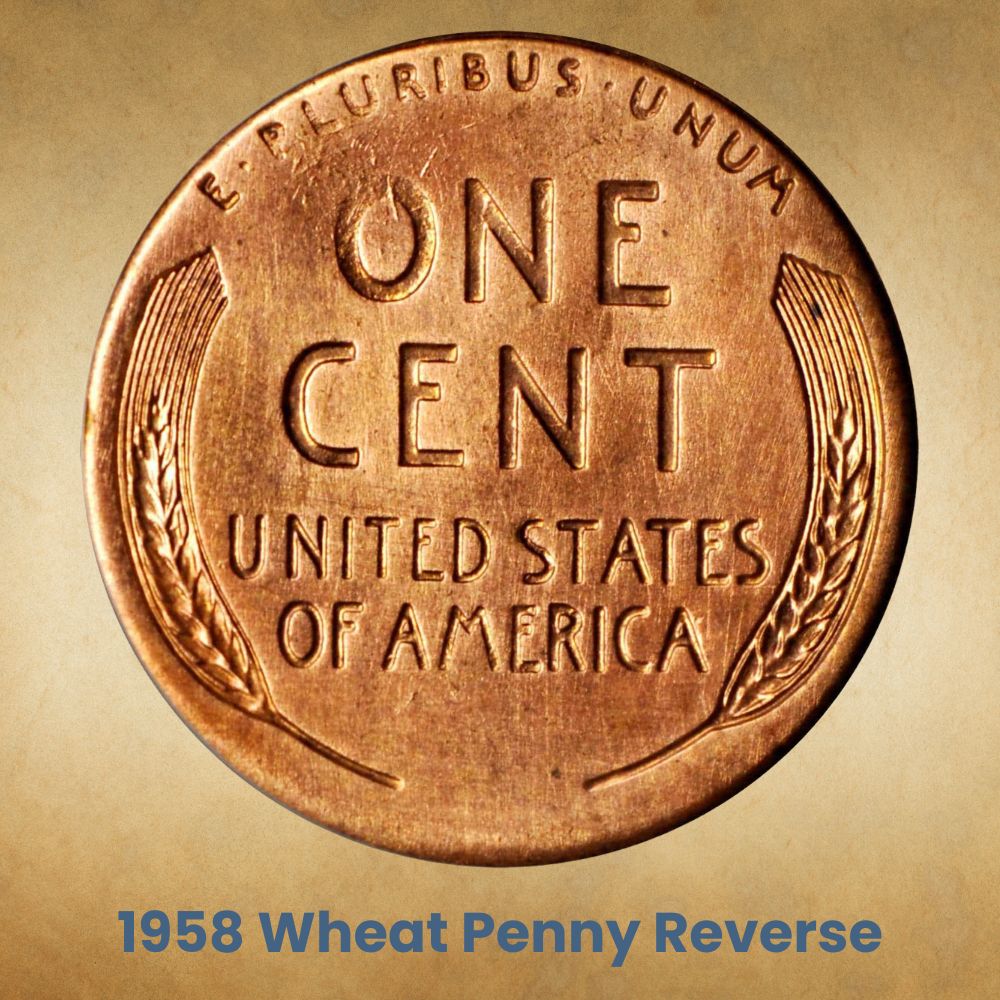
On the reverse side, you will find two wheat stalks arcing up each side of the coin, following the coin’s curved edge. In the center space of the coin is written “ONE CENT.” Above that is the phrase “E PLURIBUS UNUM,” which means “Out of Many, One,” and below it is the phrase “UNITED STATES OF AMERICA.”
Other Features of the 1958 Wheat Penny
There are many other features that make up this beautiful coin. Let’s look at a few in more detail.
Metal Composition
The metal composition of the 1958 wheat penny is 95% copper and 5% tin and zinc. This was the same metal composition used for all wheat pennies minted from 1909 to 1959.
Mint Marks and Locations
The 1958 wheat penny has the mint mark “S” for the San Francisco Mint, and it was made in Philadelphia as well. The US Mint location in Philadelphia didn’t have a mint mark, so if you have a wheat penny with no mint mark, that is where it’s from. If there is a mint mark, you will find it located on the right side of the obverse, just next to Abraham Lincoln’s shoulder.
Size and Weight
The size of the coin is 19 millimeters or 0.75 inches in diameter, and it weighs 3.11 grams. It has a thickness of 1.55 millimeters or 0.061 inches.
Frequently Asked Questions
Now that we have looked at the 1958 wheat penny value and its various error coins, let’s take a look at some of the most commonly asked questions.
What is the Average 1958 Wheat Penny Worth?
The average 1958 wheat penny in good condition is worth its face value. In uncirculated conditions, they can be worth around 30 cents on average.
What is the Most Valuable 1958 Wheat Penny?
The most valuable 1958 wheat penny is the double die error variety, which can be worth up to $219,521 in Uncirculated condition!
Conclusion
A symbol of America’s strength and independence, the 1958 wheat penny is a desirable and valuable coin for any collector. While wheat pennies from this year are worth around face value to about 15 cents, there are some error coins that can fetch hundreds or even thousands of dollars!
Be sure to keep an eye out for these rare and valuable coins when you’re out hunting for wheat pennies! You just might stumble across a treasure. Happy hunting!
Do you have a 1958 wheat penny? Let us know about it in the comments below.

I got a 1958 no mint mark it looks like other stuff wrong
Yes I have a 1958 d wheat penny, the things I’m looking at the present time are interesting for others professional to view.
I’m just mentioning this along with the 1958 d wheat penny, also a 1941 s wheat penny. A suggestion is granted.
I have a 1958 penny d double die on date
I have a 1958D D/SMM, DDO, DDR, there’s a E leaning over on the N in CENT, L is on the rim from Liberty. “R&B” in Pluribus is a smaller font than the rest. A square die chip on the rim.
I have a 1958 D penny. I actually pulled it out of my change jar because it just seems different . Problem is I don’t really understand the terms used to distinguish errors or understand the words used to determine if it is indeed rare or common.
Really new to this, but I have a 1958 D with what looks like the flakes from the “improperly annealed error” on the reverse (based on the photos you have), it’s not gouged.
I have a 1958 d double die penny on date
I have a 1958 wheat penny I would love to say I see this or I see that hell I just see old wheat penny
I have a 1958 D double die obverse wheat penny circulated and in nice condition but when I called a local coin shop they responded that they didn’t have a market for my coin
I have a 1958 D and I have 1969 s. Good condition.
I have some silver pennies also and sevetale 2009 Bicentennial pennies people. I have President Isinhower (4) & Kennedy (14) 1776 silver dollars and regular ones:18 of them total.
Oops not people and another misspelled word: several
I have a 1958 D and I have 1969 s. Good condition.
I have some silver pennies also and several 2009 Bicentennial pennies.
I have President Isinhower, silver bow dollars 1776(4) & President Kennedy (14) 1776 silver dollars and regular ones:18 of them total.
I have a 1958 wheat penny no mint mark
Hi my name is Julie I have a 1958 D wheat penny that is missing the ( . ) where they should be on my penny
(E PLURIBUS UNUM) I have a very clean clear picture of my coin as it shows where the ( . ) should be but clearly was never there. I really thought I had read to look for that error on the 1958 D penny mostly because I was looking for that error on the 1958 penny and to my surprise out of the 5 1958 wheat pennies I have I found one of my 1958 D penny sure enough was missing those ( . ) Right where I read the error could be. But, now everywhere I’ve read about the errors of the 1958 wheat penny the error that I have on mine isn’t mentioned at all. I hope ive described the error to be easily understood. I’d really appreciate any help or advice anyone might have about my 1958 D missing ( . ) error. Thank you very much for your time.
I have a 1958 D wheat penny and it’s in pretty good condition, I also have a 1941 Dime and other coins in my position, text in back if interested.
I believe I have found a 1958 D ddr,ddo penny in mint state just found today
I have a 1958 wheat Penny in exceptional shape and unless I’m just wanting to see it so bad I’m seeing things I swear I think it’s doubled not as much as what I have seen but I think the ear is doubled too I would like some other opinions I don’t see where to attach a picture
I have 50 1958 wheat pennies with no mint mark. What would the value be. I don’t believe they were circulated.
Hi I have a 1958 d double die I want to see if where that I can sell it or for you guys or anybody know that you know is interesting and buy it it’s in really nice nice beautiful wonderful conditions contact me please if you interested the double die is a front and the backI I have a 1909 V.D.B wheat V.F. penny double die